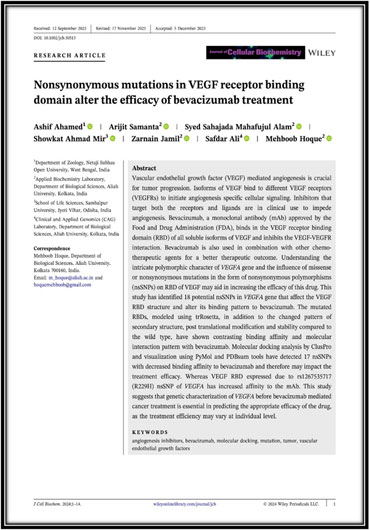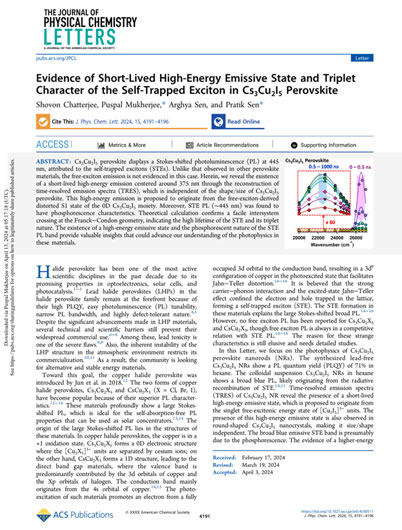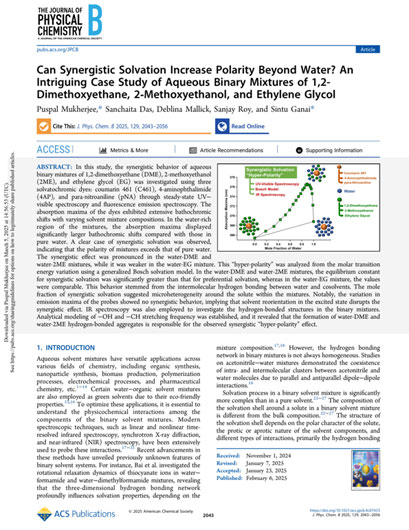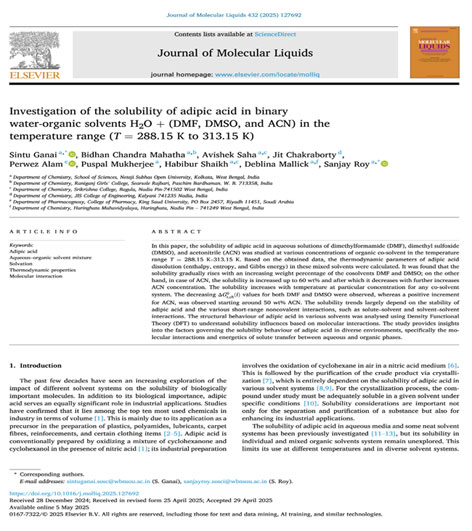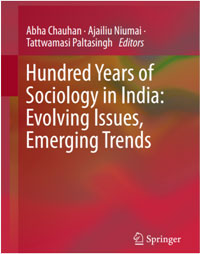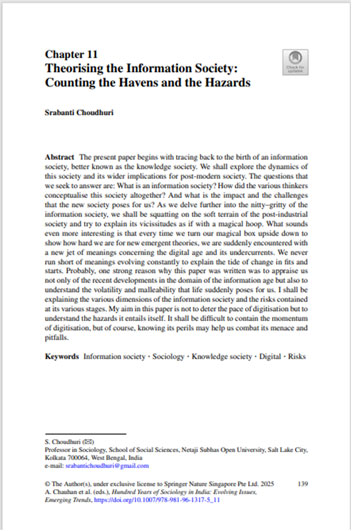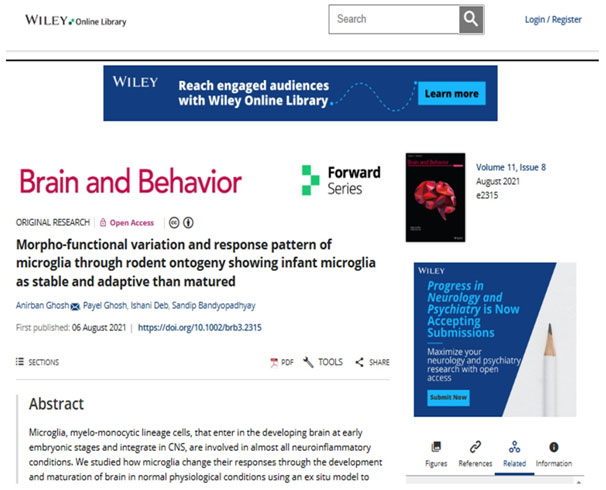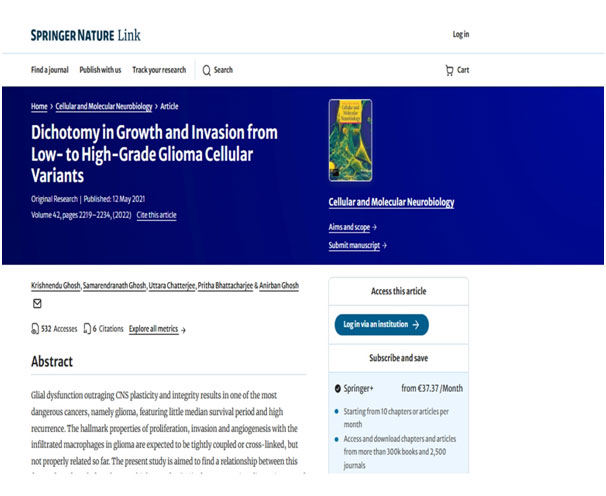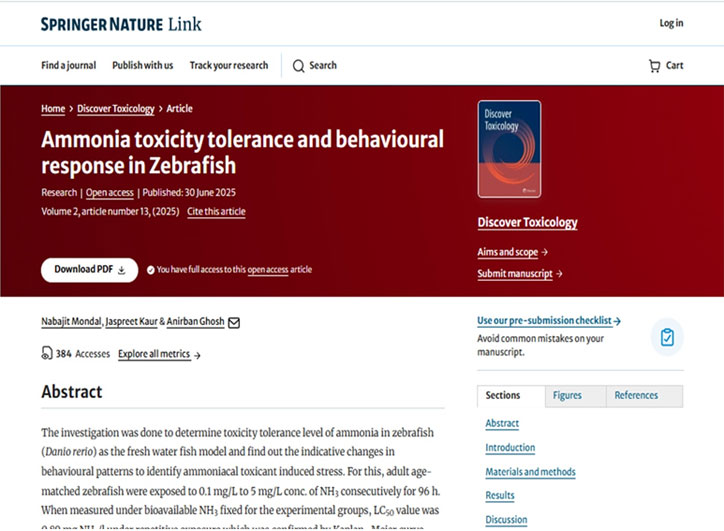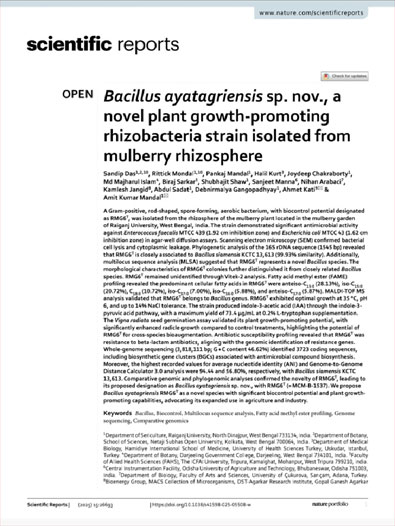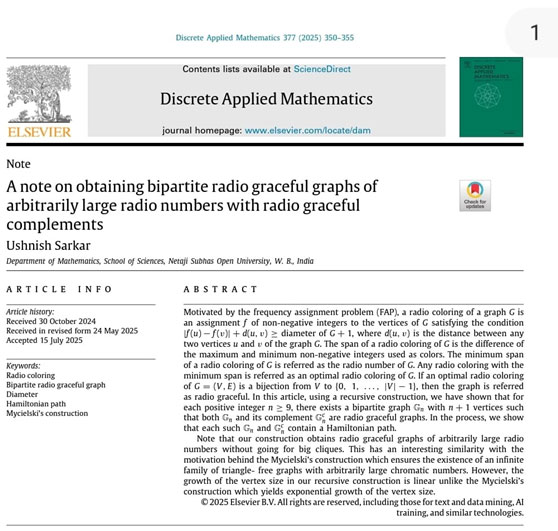Faculty Publications
| Paper Title | Author Name | Link |
|---|---|---|
|
Nonsynonymous mutations in VEGF receptor binding domain alter the efficacy of bevacizumab treatment. https://doi.org/10.1002/jcb.30515 |
Ashif Ahamed Assistant Professor of Zoology School of Sciences, NSOU |
Detail |
|
Our study investigated how nonsynonymous mutations (nsSNPs) in the VEGF-A gene impact the efficacy of bevacizumab, a cancer drug that inhibits tumour angiogenesis by binding to the receptor binding domain of VEGF-A. Using computer-based tools, 18 potentially deleterious mutations were identified. Analysis showed that 17 of these mutations may reduce binding effectiveness of this cancer drug, potentially decreasing treatment success. However, one mutation, R229H, may enhance binding affinity. These findings highlight the importance of characterizing a patient's VEGF-A gene before bevacizumab treatment to predict its efficacy and guide personalized cancer care, ensuring better therapeutic outcomes. * Ashif Ahamed is now working as Assistant Professor of Botany, Netaji Subhas Open University. Author can be reached at ashifahamed.sosci@wbnsou.ac.in |
||
|
Evidence of Short-Lived High-Energy Emissive State and Triplet Character of the Self-Trapped Exciton in Cs3Cu2I5 Perovskite. https://doi.org/10.1021/acs.jpclett.4c00511 |
Dr. Puspal Mukherjee Assistant Professor of Chemistry School of Sciences, NSOU |
Detail |
|
Dr. Puspal Mukherjee is now working as Assistant Professor of Chemistry, Netaji Subhas Open University. Author can be reached at puspalmukherjee.sosci@wbnsou.ac.in |
||
|
Can Synergistic Solvation Increase Polarity Beyond Water? An Intriguing Case Study of Aqueous Binary Mixtures of 1,2-Dimethoxyethane, 2-Methoxyethanol, and Ethylene Glycol. https://doi.org/10.1021/acs.jpcb.4c07433 |
Dr. Puspal Mukherjee Assistant Professor of Chemistry School of Sciences, NSOU |
Detail |
|
*Dr. Puspal Mukherjee is now working as Assistant Professor of Chemistry, Netaji Subhas Open University. Author can be reached at puspalmukherjee.sosci@wbnsou.ac.in |
||
|
Photophysical properties of coumarin-annulated thiazole derivatives: A combined experimental and computational study. https://doi.org/10.1016/j.molstruc.2025.142838 |
Dr. Sintu Ganai Assistant Professor of Chemistry School of Sciences, NSOU |
Detail |
|
|
||
|
Investigation of the solubility of adipic acid in binary water-organic solvents H2O + (DMF, DMSO, and ACN) in the temperature range (T = 288.15 K to 313.15 K). https://doi.org/10.1016/j.molliq.2025.127692 |
Dr. Sintu Ganai Assistant Professor of Chemistry School of Sciences, NSOU |
Detail |
|
|
||
|
Theorising the Information Society: Counting the Havens and the Hazards. https://doi.org/10.1007/978-981-96-1317-5_11 |
Dr. Srabanti Choudhury Assistant Professor of Sociology, School of Social Sciences, NSOU |
Detail |
|
For Citation:
Choudhuri, S. (2025). Theorising the Information Society: Counting the Havens and the Hazards. In A. Chauhan, A. Niumai& T. Paltasingh (Eds.), Hundred Years of Sociology in India: Evolving Issues, Emerging Trends (pp. 139-148). Singapore: Springer Nature Singapore. https://doi.org/10.1007/978-981-96-1317-5_11 . ISBN 978-981-96-1316-8 My research has been published by Springer Nature as a book chapter in the international volume Hundred Years of Sociology in India: Evolving Issues, Emerging Trends. This prestigious book, edited by Prof. Abha Chauhan (Central University of Himachal Pradesh), Prof. Ajailiu Niumai (University of Hyderabad) et al, is a landmark scholarly endeavour commemorating a century of Sociology in India. It brings together selected contributions from leading sociologists across the country, originally presented at the 47th All India Sociological Conference, and addresses evolving issues, diverse perspectives, and emerging trends within the discipline. My chapter, titled "Theorising the Information Society: Counting the Havens and the Hazards", explores the complexities of the information and knowledge society within the larger context of post-industrial and post-modern transformations. In this work, I attempt to trace how different thinkers have conceptualised the information society, while also interrogating its promises and perils. On the one hand, I examine the "havens" of connectivity, innovation, and knowledge flows; on the other, I critically analyse the "hazards" of inequality, surveillance, exclusion, and the volatility that the digital age generates. The chapter reflects my commitment to advancing critical sociological inquiry by situating Indian experiences within global debates on digital transformations. Having my research included in this Springer-published volume is both a professional honour and an encouragement to continue strengthening the research culture of Netaji Subhas Open University through globally relevant, socially engaged scholarship. |
||
|
Morpho-functional variation and response pattern of microglia through rodent ontogeny showing infant microglia as stable and adaptive than matured. http://doi.org/10.1002/brb3.2315 |
Dr. Anirban Ghosh Professor of Zoology, School of Sciences, NSOU |
Detail |
|
Microglia is a very important cell in brain which is designated as the gatekeeper or sentinel of CNS tissue. They are very vigilant and reactive to protect the neurons and other brain cells so that we can think and work properly.
Our team studied the characteristics of microglia from infant to adult brain with their morphological modifications and functional changes in terms of cellular protein, cytokine or other factor released by the cells to interact and modulate surrounding cells including neurons. Also, we measured how microglia behaves under different cytokine environment. Interestingly, we found that, the microglia cells isolated from infant are healthiest and adaptive under different situations with high survivability. This was a fundamental work of neuroimmunology performed in rat as the model organism and practically important to do research on microglia in artificial environment out of the body, i.e., in culture. The entire work was supported by both SERB and ICMR with their project funding. |
||
|
Dichotomy in Growth and Invasion from Low-to High-Grade Glioma Cellular Variants. http://doi.org/10.1007/s10571-021-01096-1 |
Dr. Anirban Ghosh Professor of Zoology, School of Sciences, NSOU |
Detail |
|
Glioma is the most dangerous and aggressive type of brain cancer which shown a maximum of 12-18 months of median survival period after diagnosis. My team made a detailed cellular and molecular study on the dissected glioma samples of patients and came up with some interesting results. We found that low-grade glioma, which was thought apparently less aggressive, actually laid the foundation of invasiveness of glioma for the later stages. Based on such ground work, the later stage can show such devastating consequences in brain tissue. This was a very significant information to formulate the strategy of treatment of glioma, if detected earlier. This work was funded mainly by CSIR and partially by ICMR.
|
||
|
Ammonia toxicity tolerance and behavioural response in Zebrafish. https://doi.org/10.1007/s44339-025-00028-8 |
Dr. Anirban Ghosh Professor of Zoology, School of Sciences, NSOU |
Detail |
|
Ammonia and related chemicals are always contaminating the ponds, lakes, canals and rivers due to industrial affluents, fertilizers, and many other sources. Fishes are grown in the aquatic systems or within the fish farming environment are always tolerating such ammonia and nitrogenous by-product contamination. In this part of study, we tried to observe, record and interpret the effect of ammonia on zebrafish as model organism. Here we determined the level of ammonia stress that zebrafish can tolerate and also how such contamination levels affect or alter their behaviour, as well as, to what level such ammonia become fatal to the organism. We identified the behavioural modifications which are the indicator of such stress with quantitative estimation of behavioural shifts.
With these primary findings we are now investigating how ammonia stress is related with behavioural modifications along with the underlying neurophysiological changes due to such stress. |
||
|
Bacillus ayatagriensis sp. nov., a novel plant growth-promoting rhizobacteria strain isolated from the mulberry rhizosphere. https://doi.org/10.1016/j.dam.2025.07.012 |
Shri Sandip Das Assistant Professor of Botany, School of Sciences, NSOU |
Detail |
|
I recently published an article in Scientific Reports, Nature titled "Bacillus ayatagriensis sp. nov., a novel plant growth-promoting rhizobacteria strain isolated from the mulberry rhizosphere". This work reports the discovery and taxonomic characterization of a previously unknown Bacillus species with significant plant growth-promoting traits. Genomic and physiological analyses revealed its unique functional capabilities, suggesting promising applications in sustainable agriculture and sericulture. The study expands microbial diversity knowledge while underscoring its potential role in eco-friendly crop management.
This investigation was supported by Netaji Subhas Open University (NSOU), Kolkata and Raiganj University, Raiganj whose basic facilities and encouragement made the study possible. |
||
|
A note on obtaining bipartite radio graceful graphs of arbitrarily large radio numbers with radio graceful complements. https://doi.org/10.1016/j.dam.2025.07.012 |
Dr. Ushnish Sarkar Assistant Professor of Mathematics, School of Sciences, NSOU |
Detail |
|
Recently, I have published anarticle in Discrete Applied Mathematics. Its title is "A note on obtaining bipartite radio graceful graphs of arbitrarily large radio numbers with radio graceful complements" (https://doi.org/10.1016/j.dam.2025.07.012 ). This work achieves two main things.
|
||
News & Notifications



